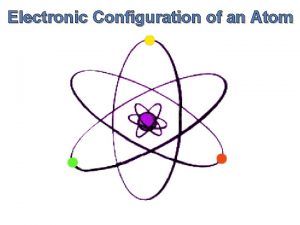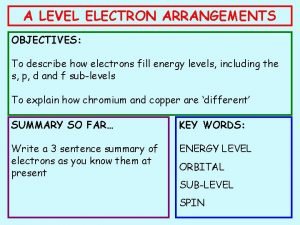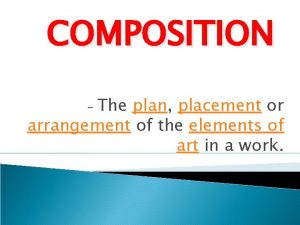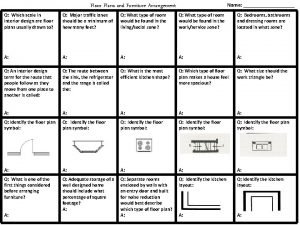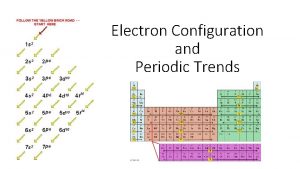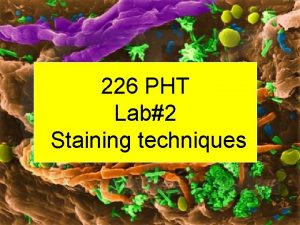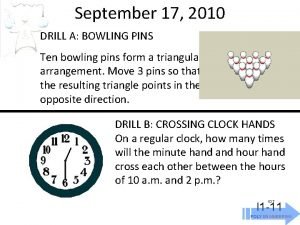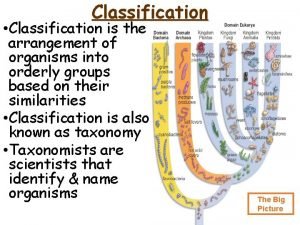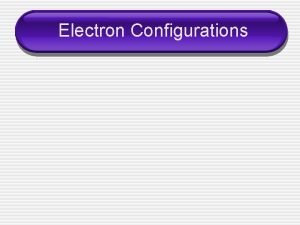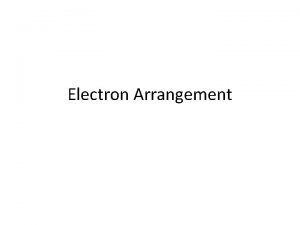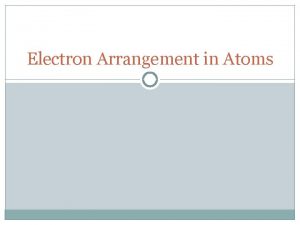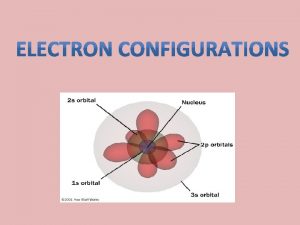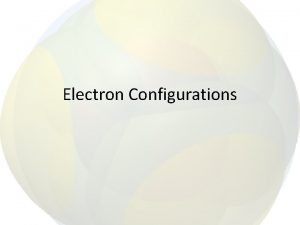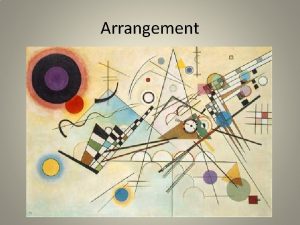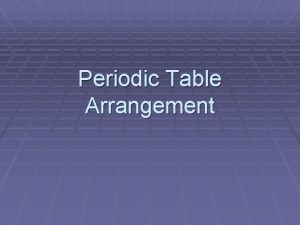Electron Arrangement 2 3 Electron arrangement 2 3































- Slides: 31

Electron Arrangement

• 2. 3 Electron arrangement • 2. 3. 1 Describe the electromagnetic spectrum. • 2. 3. 2 Distinguish between a continuous spectrum and a line spectrum. • 2. 3. 3 Explain how the lines in the emission spectrum of hydrogen are related to electron energy levels. • 2. 3. 4 Deduce the electron arrangement for atoms and ions up to Z=20.


Shinjuku by night “The neon capital of the world” How do neon lights work? Why do different gases give out different colours? • We can use this information to begin building a picture of how electrons are arranged in atoms. • You may already know about how electrons are arranged (from IGCSE), but we can’t see electrons, so how do we know? • •

First we have to learn a little bit about light • Light is part of the electromagnetic spectrum. • This is energy given out by the sun (among other things!) • The electromagnetic spectrum is the full range of electromagnetic radiation.


• We only need to think about the visible spectrum. (For now!) • If we examine light from the sun, we see a continuous spectrum

• This means that the spectrum shows all the frequencies of visible light • i. e. it contains all the colours, and has no gaps. • If we look at the spectrum from hydrogen gas (we are using Hydrogen as an example because it is the simplest element) We see something very different!

We see a line spectrum – a spectrum which only shows certain frequencies of visible light.


Hydrogen Emission Spectra Experiment – Experimental Observations Energy added in the form of heat, electricity or light → only certain specific colors of light are emitted Thus only specific energies are emitted

• This presents us with a number of problems to explain: – How can an atom absorb or emit light energy? – Why is the energy absorbed or emitted only at specific frequencies? • We also have to explain why the electrons that are orbiting the nucleus don’t just crash into the nucleus (remember opposite charges attract)

The Bohr Model of an Atom • In order to explain the observations, we must place restrictions on exactly where the electrons may be. • The electrons are quantized. • I. e. they can only exist at certain specific energy values. • This is known as the Bohr model of an atom.

Postulates of Bohr model • Electrons can have only certain specific values of energy. • Electrons travel in fixed, circular orbits* • When an electron absorbs the exact difference in energy between 2 levels it makes a quantum leap up • When an electron makes a quantum leap down it releases the exact difference in energy between two levels. • * = we no longer believe this postulate


• Hydrogen only has one electron so it is easy to visualise the changes in quantum level. • For the emission spectrum the electron drops quantum levels. • Light of one particular energy (frequency) is given out when an electron drops from n=2 to n=1. • More energy is given out when an electron drops from n=3 to n=1 • So the light given out has a higher frequency • Further frequencies are given out for n=4 n=1; n=5 n=1 etc.

• In practice the hydrogen spectrum is divided into a number of series. • These series are identical in form but occur at different frequencies. • The series we have discussed produces lines in the ultraviolet region of the spectrum. • This is because a transition to n=1 always releases a lot of energy. • It is known as the Lyman series.

• A second series is produced for transitions to n=2 (i. e. n=3 n=2 ; n=4 n=2 etc. ) • This is a lower energy spectrum • Why? • This series is called the Balmer series and is in the visible region of the E. M. Spectrum • The Paschen series is in the infrared region and is produced by electrons dropping back to the n=3 level

Hydrogen Atom and Emission Balmer Lyman Paschen


• Notice that the because the lines get closer at high frequency (low wavelength) • We can deduce that the quantum levels get closer at high energy levels

• We can also have an absorption spectrum for hydrogen. • If white light is shone at hydrogen, only specific frequencies are absorbed. • These correspond to the frequencies given out in the emission spectrum

• How can you explain this?

Electronic Structure for Atoms up to Z=20 • The energy levels closer to the nucleus are more stable • So they tend to fill before energy levels further away. • There is a maximum number of electrons that each energy level can hold. • The first can hold 2 electrons • The second can hold 8 electrons

• Beyond this it becomes more complicated • But the next 8 electrons go into the third energy level • The next 2 go into the fourth energy level. • Each energy level is called an orbital (or shell) • If a question asks for the electronic structure of an atom, we must give the number of electrons in each orbital.

• E. g. what is the electronic structure of aluminium? • From the periodic table, Al has 13 protons • Therefore it has 13 electrons. • 2 in the first orbital • 8 in the second • And 3 in the third. • We can represent this by 2, 8, 3

• The number of electrons an element has determines its chemical properties • In particular chemists are concerned with the outermost shell of electrons • The valence electrons. • The position of an element in the periodic table is closely related to its electronic structure. • The period (or row) tells us how many energy levels are occupied. • The group tells us how many electrons are in the valence shell.

• E. g. Phosphorous is in Group 5 and the third period. • So it has 3 occupied shells • And the outer shell has 5 electrons. • SL candidates need to be able to give the electronic structure for the first 20 elements • This is exactly the same requirement as IGCSE


• 2. 3 Electron arrangement • 2. 3. 1 Describe the electromagnetic spectrum. • 2. 3. 2 Distinguish between a continuous spectrum and a line spectrum. • 2. 3. 3 Explain how the lines in the emission spectrum of hydrogen are related to electron energy levels. • 2. 3. 4 Deduce the electron arrangement for atoms and ions up to Z=20.

 Aluminium oxide bond
Aluminium oxide bond Tetrachloromethane electron arrangement
Tetrachloromethane electron arrangement Shape of s orbital
Shape of s orbital Composition is the arrangement of
Composition is the arrangement of Currency board
Currency board Circular arrangement questions
Circular arrangement questions Equilateral triangle arrangement
Equilateral triangle arrangement Name arrangement
Name arrangement Ancient roman floral design
Ancient roman floral design Asymmetrical balance in floral design
Asymmetrical balance in floral design Hierarchy of f&b department
Hierarchy of f&b department Fungsi transfer
Fungsi transfer Electron configuration
Electron configuration Lever body part
Lever body part Scalene triangle flower arrangement
Scalene triangle flower arrangement Systematic arrangement
Systematic arrangement The arrangement of a phenomenon across earth's surface is
The arrangement of a phenomenon across earth's surface is Bacillus subtilis morphology and arrangement
Bacillus subtilis morphology and arrangement Bowling pins arrangement
Bowling pins arrangement Meq1 tcode in sap
Meq1 tcode in sap Broken back driveline arrangement
Broken back driveline arrangement Monkey face leaf scar
Monkey face leaf scar Soil arrangement
Soil arrangement Multifiber arrangement
Multifiber arrangement Classification arrangement
Classification arrangement Balance articulation sequence integration continuity
Balance articulation sequence integration continuity A chronological pattern of arrangement follows the
A chronological pattern of arrangement follows the The arrangement of the story
The arrangement of the story Chinese zodiac signs story
Chinese zodiac signs story Baroque floral design history
Baroque floral design history Arrangement of information
Arrangement of information Pseudomonas aeruginosa arrangement
Pseudomonas aeruginosa arrangement
